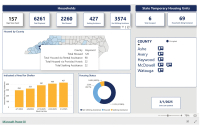Smaller increases slated for Waynesville electric customers

Duke Energy isn’t the only utility company raising its electric rates this year amidst rising energy costs, but some local electric customers will see a better deal than others.
The Town of Waynesville is one of North Carolina’s so-called “electric cities” meaning it purchases power from a supplier — formerly Duke — and resells it to its own 3,000 customers.
But now Waynesville purchases power from Santee Cooper; Duke offered to renew its contract with the town, at $79.3 million over 10 years, a deal that compared poorly to Santee Cooper’s $54.1 million bid, especially in light of Duke’s intention to pass along its coal ash cleanup costs to consumers.
The new contract with Santee Cooper, however, is still higher than the old one with Duke; that’s why last October, consultants recommended Waynesville raise its rates by 12 percent, compared to a requested rate increase by Duke of around 15 percent.
“When we talked about a rate increase, people were scratching their heads saying, ‘Wait a minute, I thought we were going to save money, now you’re talking about a rate increase?’” said Waynesville Town Manager Rob Hites.
It’s true, but it’s not — while a cost savings over the bid Duke Energy submitted to retain its relationship with Waynesville, the new Santee Cooper contract reflects that energy prices have been climbing for some time now.
Related Items
Hites said that the town’s increase will probably come in much lower than the 12 percent suggestion.
“We recommended a two-phase increase that’s effective Jan. 1 and it’s a 5 percent increase across the board for all rate classes,” Hites said. “What we planned to do was to see how revenues came in on that 5 percent, and as we approach the budget, probably around the first of April when we’re finalizing our figures, we’ll look again at the impact of that 5 percent and fine-tune the second phase.”
Hites said that he predicts the second phase, which would take effect July 1, will be about 4 percent, but notes it could just as easily be 3 percent or 5 percent.
“What we’re really doing is bringing the rate base in line with the new contract we signed with Santee Cooper,” he said. “I think that the way the contract came across, the contract was going to save money. The majority of the rate increase is simply passing through the rate increase [from Santee Cooper].”
Waynesville electric customers can not only look forward to lower rates than Duke’s customers, but can also rest assured they won’t be on the hook for Duke’s coal ash cleanup costs.
“One of the main public policy issues that they’re having is whether the rate payers should be responsible for paying for the remediation of the coal ash reservoirs,” said Hites. “Duke’s even charging a profit on the removal of the coal ash. It very well could go to court. And of course, Santee Cooper is South Carolina’s power agency, so, we’re not in the coal ash removal business right now.”
Last year, rather than pass along a rate increase associated with the new Santee Cooper contract, the town chose to simply absorb a $200,000 loss.













